Everything You Need To Know About Solar Powered Pool Pumps
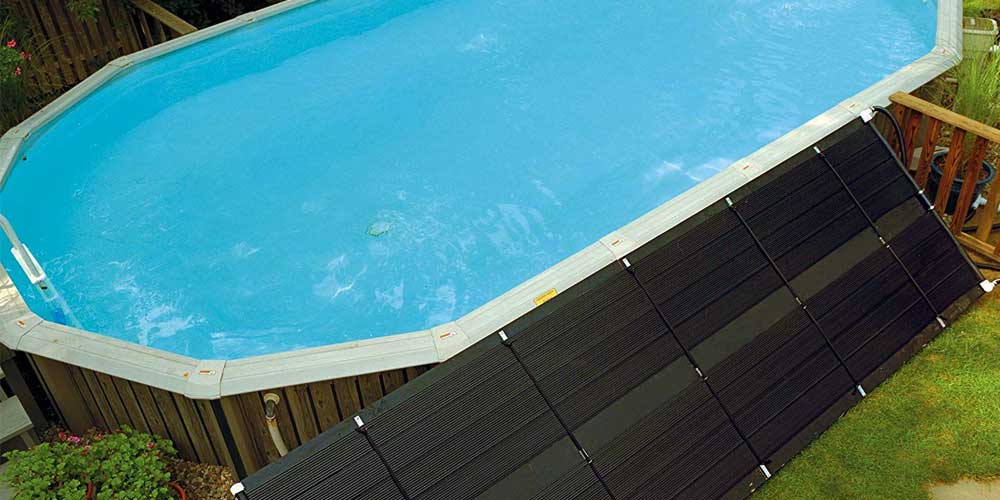
If you’re someone who loves to take a good dip into the cool or warm pool water during the day to freshen up your mind and body, you’d probably know exactly how difficult it is to maintain a pool.
Thousands of people across the world, especially in America, who have pools, whether above or in-ground, know that it is extremely time-consuming and pretty expensive to look after one.
In order to keep your pool squeaky clean for swimming, you have to have your pool water filtered and circulated every now and then, following up with a distribution of proper chemicals to keep the water intact.
Apart from providing a lot of your time to it, you’d also require to invest in a filtration system and a pool pump to regulate your clean pool water.
In most cases, many pool owners run their grid-powdered pool pumps the whole night to cut on the electricity costs. However, running a full recycling and filtration system every night, regardless of the cost lesser or more, will add up to the annual electricity bill, which will definitely end up being a lot more.
So then, how can we possibly address this issue? The best way to do it is by switching on to a solar pump, i.e., investing in a renewable energy alternative.
However, before you decide to invest in a solar pump, there are a few things that you need to know. The principal difference between a conventional pool pump and a solar pool pump is that the former runs on electricity siphoned from the grid, whereas the latter acquires all the energy from direct sunlight to run the pump.
Although solar pool pumps are quite expensive to install, they can quite often live up to their worth. Solar-powered designs are most efficient with long life expectancy, ensuring proper functioning for the long run without any hassle.
Therefore, to find out more on solar-driven energy and solar pool pumps, let’s take a detailed look at further information of the system, how it works and which one to consider the best among the many.
- 1. Solar Pool Pumps Vs. Regular Pool Pumps
-
2.
Popular Solar Pool Pump Questions
- 2.1. 1. Do Solar Pool Pumps Work?
- 2.2. 2. How Many Solar Panels Are Required To Make The Pool Pumps Work?
- 2.3. 3. Cost Of Solar Pool Pump
- 2.4. 4. How To Connect A Solar Panel To The Pool Pump?
- 2.5. 5. Best Time To Run Solar Powered Pool Pumps
- 2.6. 6. Can You Run The Solar Pool Pump With Solar Covers On?
- 2.7. 7. Does Home Insurance Cover Swimming Pools?
- 2.8. 8. Does Home Insurance Cover Swimming Pool Pumps?
- 3. Our Solar Powered Pool Pump Choices
- 4. How To Choose A Solar Pool Pump?
- 5. Conclusion
Solar Pool Pumps Vs. Regular Pool Pumps
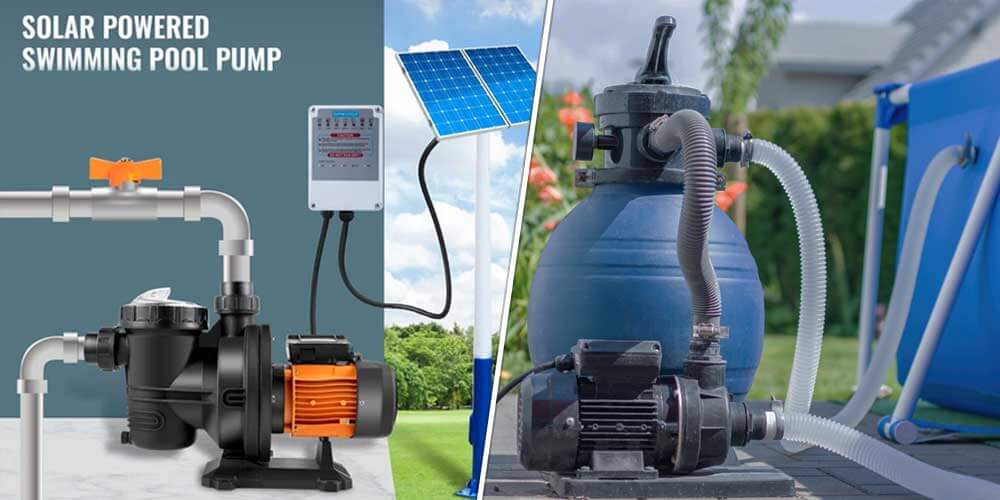
In comparison to conventional pool pumps, solar pool pumps possess a lot of benefits that enhance the filtration system of your pool water with regard to your convenience and comfortable annual maintenance costs.
Solar-powered pool pumps have a longer life expectancy than conventional pool pumps and are quite efficient in their jobs. The former is also easier to maintain when it comes to filtration and cleaning and is designed to be managed by individuals themselves.
Although not all solar pool pump kits are designed for individuals to use by themselves, there are many newer models that lessen the hassle of depending upon professionals to install the solar-powered pool pump.
Solar-powered pool pumps cut on necessary expenses, making it the absolute best choice for people adopting a cost-effective lifestyle.
Popular Solar Pool Pump Questions
As we have discussed previously at the beginning of this blog, the installation of solar-powered pool pumps actually provides a more efficient way of ensuring a good filtration system for your pool without having to worry about your electricity bills.
If operated properly, most of them can even be maintenance-free. However, mentioned below are some of the frequently asked questions (FAQs) regarding solar-powered pool pump kits, their usage, durability, cost, etc. You can also go through this article, if you have doubts or want to know more about solar panels.
1. Do Solar Pool Pumps Work?
To answer that question in simple words, yes, solar pool pumps actually work great. Solar-powered pumps for pools have better efficiency in comparison to regular pool pumps.
They are not much different than regular pool pumps when it comes to functioning. However, one of the best things about solar-powered pool pumps is that they get free access to sunlight energy which is superior to electricity or fossil fuel-based energy. If you find solar pool pump inconvenient for you, you can try solar pool rings, to heat your pool water
2. How Many Solar Panels Are Required To Make The Pool Pumps Work?
To begin with, residential pools mostly operate with single or more horsepower solar heater pumps with variable speed choices. These pumps will eventually draw almost 800 watts/horsepower of energy per hour which marks 4-6 solar panels will suffice to operate a solar pool pump, depending upon the size of the solar panels.
Next, you should place them in areas that have proper sunlight exposure, such as apartment rooftops, pool house roofs, the backyard, etc.
3. Cost Of Solar Pool Pump
Generally, a solar-powered pool pump’s installation costs can range from $3,000-$4,000, including purchase and professional installation charges. The most notable differences between solar pool pumps and other options (gas and electrical pumps) are:
- Producing solar energy to acquire the most cost-effective method for operating a pool pump.
- The overall/annual cost of operation.
Therefore, let’s catch a glimpse of all the benefits associated with the installation of a solar pool pump:
- They save energy and help to maintain pool temperature for convenience.
- A solar pool pump’s life expectancy is more than that of a regular pool pump, i.e., 3-5 years and 10 and more, respectively.
- A brushless solar pool pump has zero contact with anything, reducing the hassle of repairing or replacing any brush every few years.
- Similar to regular pool pumps, solar-powered pool pumps also provide a filtration system by removing debris and re-circulating water in the pool efficiently.
- In the case of solar pool pumps, the operational costs are much less with more efficiency than in comparison to traditional pool pumps.
- Solar pool pumps are cost-effective.
4. How To Connect A Solar Panel To The Pool Pump?
The solar panels can be installed on the pool pump, and it follows a very simple method to do it. One can easily opt for installing the panels themselves, provided they are guided with proper instructions.
The installation of solar pool pumps will require you to connect the pump’s return hose to the panel’s inlet, which in return will bring cold water from the pool into the solar-powered heater. To obtain warm water from the panel into the pool, you have to connect the return hose to the solar panel outlet as well as the pool return.
However, you can always opt for professional help in case you don’t feel confident enough to install the pool pump yourself.
5. Best Time To Run Solar Powered Pool Pumps
To be fair, it is better to run a conventional pool pump at night and during hours that do not pick up high electricity costs. However, it is completely the opposite in the case of a solar-powered pool pump (especially the time between 10 a.m. to 3 p.m. when the sun shines the brightest).
Circulating the pool water helps in debris removal and ensures that all chemicals reach every corner of the pool. Approximately, it may take up to six hours or more to efficiently run a whole cycle of the pool’s filtration system.
6. Can You Run The Solar Pool Pump With Solar Covers On?
You can run the solar pool pump with solar covers on. A solar cover technically helps to reduce heat loss and improves the overall ability of your pool to stay warm.
Therefore, running your solar pool pump with the solar covers on totally makes sense. Additionally, it also helps reduce the pump’s time and effort to increase the temperature of the water.
7. Does Home Insurance Cover Swimming Pools?
Well, to be specific, home insurance does cover swimming pools but up to a certain limit. Most home insurance policies that cover swimming pools include paying for covered repairs such as damage due to natural causes. However, these have limited liability coverage, which helps pay for guests’ injury expenses such as accidental falls and slips.
Since swimming pools are considered an “attractive nuisance”, there are many coverage limitations when it comes to home insurance policies.
8. Does Home Insurance Cover Swimming Pool Pumps?
Conventional homeowners insurance policies usually include covered perils. So, therefore, it can be said that home insurance policies do cover swimming pool pumps. However, the extent of the insurance coverage also significantly depends upon the reason behind the damage of the solar-powered pool pump system.
To provide an example, the insurance policy may cover pump damage from a tree falling over or even a clogged pump system but not in case of a burned-out pump caused due to misuse. Although, the good news is you can easily buy an equipment endorsement to cover even that.
Our Solar Powered Pool Pump Choices
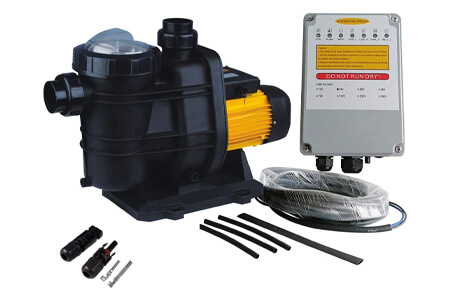
- Item Dimension: 30 x 19 x 12.5 inches
- Maximum Flow Rate: 136 GPM
- Max Water Temperature: 50°C
- Package Includes: Solar Pool Pump, MPPT Pump Controller & Cables
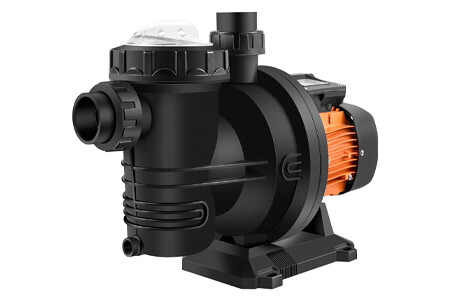
- Item Dimensions: 23 x 16.3 x 11 inches
- Maximum Flow Rate: 92 GPM
- Max Head: 62 ft/18.8 m
- Package Includes: Solar Pool Pump, MPPT Controller, Cables & Fitting Bag
How To Choose A Solar Pool Pump?
If you are on the path of switching over to using renewable energy for your pool pump, the first thing for you to do will be to choose a good-quality solar pool pump. In order to do so, here are some of the key things that your need to keep in mind:
1. Volume Of The Pool
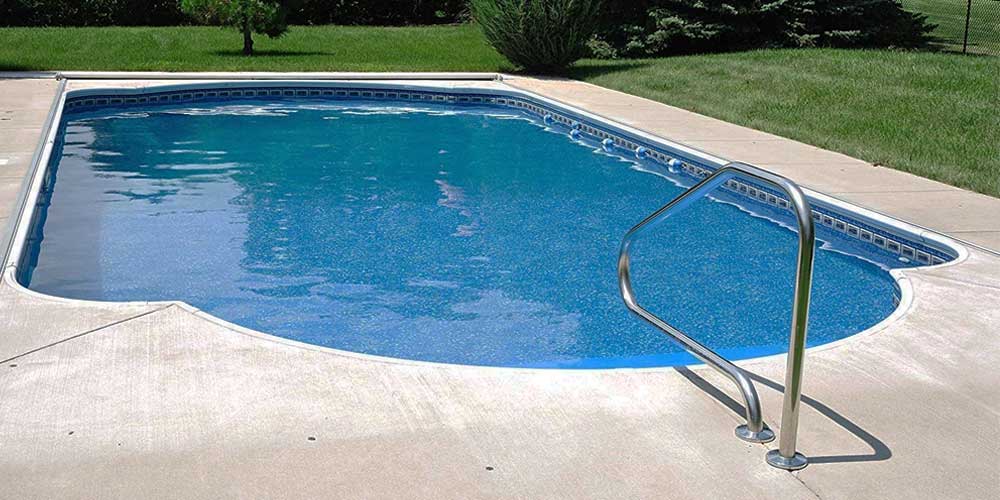
The foremost important thing that one needs to do is calculate the pool’s actual volume before actually going for solar pool pump shopping. This step is crucial to determine which pump will suit your pool the best. So, in order to calculate the volume of your pool, here are a few things that you can do:
- Firstly, you have to calculate the average depth of the pool in ft. So, add the deepest measurement of the pool to the shallowest measured, followed by dividing the result by two. The answer that you’ll get is the average depth of your pool.
- Thus, to calculate the gallon volume of a circular-shaped pool, you have to use the formula: [diameter in ft.] X [diameter in ft.] X [average depth in ft.] X 5.9 = volume in gallons.
- However, to calculate the gallon volume of a rectangular or a square-shaped pool, you have to use this formula: [length in ft.] X [width in ft.] X [average depth in ft.] X 7.5 = volume in gallons.
- Lastly, to calculate the gallon volume of an oval-shaped pool, you have to use this formula: [length in ft.] X [width in ft.] X [average depth in ft.] X 6.7 = volume in gallons.
2. Optimum Flow
Now, what is optimum flow? While purchasing a solar pool pump, you may notice that different maximum flow rates are measured in Gallons (Pumped) Per Minute or GPM.
Depending upon the volume of the pool and the number of full water recycles per day of the pool pump, the pool pump will require different GPMs to match the potential pump capacity. Therefore, to calculate the GPM or the optimum flow of your pool, follow this formula mentioned below:
- [Pool volume] X [number of desired turnovers/day which is usually 1 or 2] = total gallons/day.
- [Total gallons/hour] ÷ [60 minutes an hour] = total gallons/minute (GPM).
- [total gallons/day] ÷ [average hours sunlight that the solar panels receive per day] = total gallons/hour.
Therefore, you can obtain the minimum required GPM using this formula. Now, it’s time to calculate and find out the optimum required GPM for which we will need to average this acquired figure above against the maximum GPM of your solar pump capacity.
Maximum pumps that are available in the market usually display their maximum GPMs, which also largely relies on the sizes and lengths of the pipes used in pump filters. Generally speaking, a 1.5’ pipe has a maximum flow rate of 42 GPM, and a 2’ pipe has an average of 73 GPM.
To calculate the optimum flow rate of the pool, you have to add your minimum GPM and your maximum GPM flow rate together, followed by dividing the answer by two.
Let’s say, for example, your pool has a total volume of 16,000 gallons and requires one complete recycle a day; with regards to your solar panels receiving 10 hours of direct sunlight each day, your minimum required flow rate will be around 27 GPM.
If the pump and pipes you have opted for using a maximum flow rate of around 60 GPM, you’ll have to add 27 and 60 GPM, i.e., 87 GPM, and divide the answer by two, which comes to (87/2=43.5 GPM). Thus, the pool’s determined optimum flow will be 43.5 GPM.
3. Feet Of Resistance
Yet another crucial calculation that you need not forget is the determination of your pool’s total feet of head or feet of resistance.
This calculation sort of helps in the decision of buying the solar pump that will best suit the requirements of your pool since you’ll be made aware of the kind of horsepower it’ll need and other requirements. Therefore, let’s take a quick glance at how to perform the following calculations:
- [Pressure reading or PSI into the filter tank] X 2.31 – [note the answer].
- [Suction line reading or PSI from the vacuum] X 1.13 – 9-[note the answer].
- Add both the answers to determine the pool’s feet of resistance.
4. Bush Or Brushless Motor
In all honesty, pool pump motors that have brushes require a lot of consistent maintenance, which can often result in the cost negating the money that you save by switching over to solar-powered pool pumps. Therefore, it is wise to purchase a brushless model to save yourself from all the hassle of brushes that may ring along.
5. Solar Panels

Many models in the market provide you with a complete solar pool pump kit, ready for you to install as soon as you purchase them, including solar panels.
However, there are also many others that do not come with included solar panels, which brings us to the dilemma of choosing between the best of options to choose the better suited solar panels for your pool pump.
Although it may seem scary at the beginning to search for the best option available in the market, it is not that complicated. Here are four things that you need to keep in mind before you go solar panel shopping:
Monocrystalline Technology: They are the most advanced solar power cells in the market, designed to work very well even in low-light situations. Polycrystalline is a cheaper alternative, which is considered an absolutely bad idea to use in a pool pump.
Wattage: after you have shortlisted the few options that you feel are well suited, you will require finding the wattage of the pump, followed by the average wattage output of the solar panels.
For example, if the solar panels are 165W, you’ll need 4 of these to safely cover the needs of your pool pump (4 X 165W = 660W).
Solar-combo: To elaborate, while setting up your solar pool pump, you can either wire the solar panels directly to your pump or to a battery that will be connected to the pump. This will store the electricity generated during daylight, and you can easily use it to run the pump overnight.
Positioning of the solar panels: This is essentially the most important step. You have to put in your best thought to determine the positioning of your solar panels at a place under direct and adequate sunlight.
It is advised to place them up south-facing and tilted at a 45-degree angle, ensuring there are no trees, telephone wires, shrubs, etc., to cast a shadow over your solar panels.
In simple words, you have to make sure that your solar panels are exposed to the maximum sunlight during the day, without any disturbances. Also, remember to position your solar panels closer to the pool pump for better functioning.
6. Budget
It is needless to mention that budget is an important aspect while purchasing a solar pool pump. Although the idea of it, along with its provided benefits and convenience, using renewable energy such as solar energy (check the advantages and disadvantages of using solar energy) is still a bit expensive in comparison to your everyday means of consuming electricity.
To provide a rough sketch of the scenario, a complete solar pool pump including solar panels may cost you around $3,000-$5,000.
However, these are known for their durability and are meant to function for almost 10-15 years (or above!), without requiring anything else but annual maintenance.
Adding to the green energy federal tax credit incentives imposed by various governments across the world, you may be looking at a $4,000 kit now only costing you $2,800.
Conclusion
Concluding the detailed discussion on solar panels for pool pumps, solar-powered pool pump kit, budget, versatility, installation, etc., it can be said that there are many available great solar pool pumps in the market, for example, the Sunray 2HP 180V Solar Pool Pump.
Most solar pool pump kits in the market are designed to be able to install them on your own since solar panels are fairly easy to install. Once they’ve been positioned, all you will really need to do is to wire them into something for them to start generating.

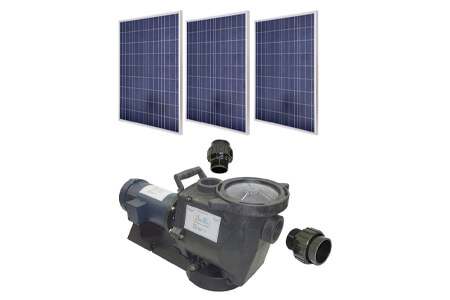
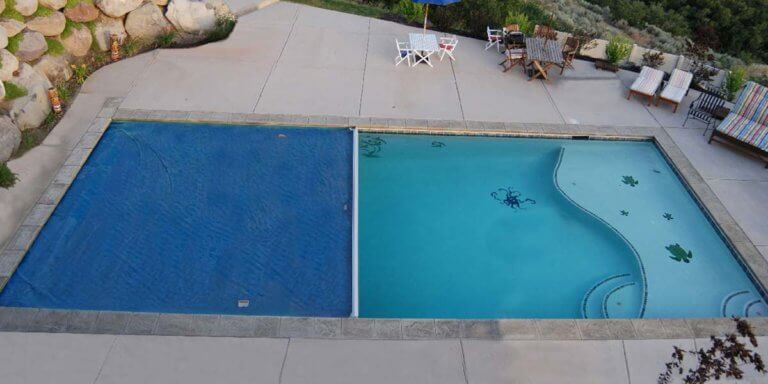
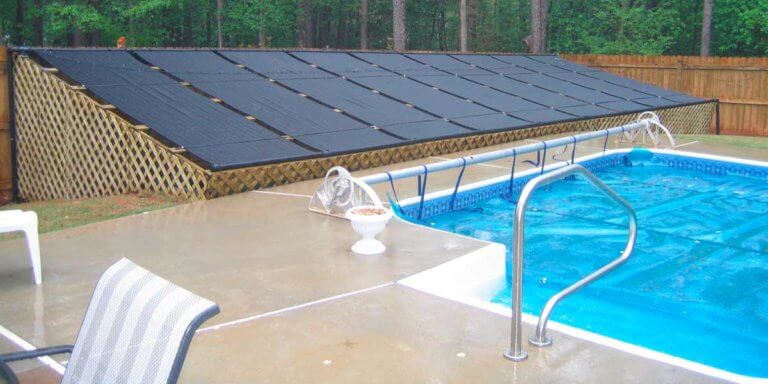

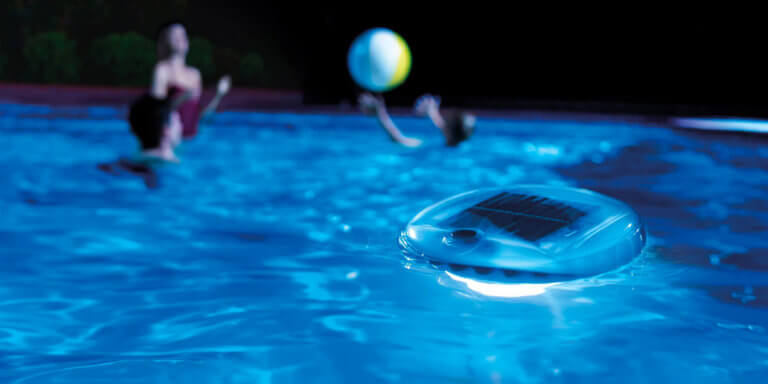

![Best Solar Rings for Pool [2023 Updated] | Reviews and Guide](https://heliushub.com/wp-content/uploads/2021/06/Best-Solar-Pool-Rings-768x384.jpg)